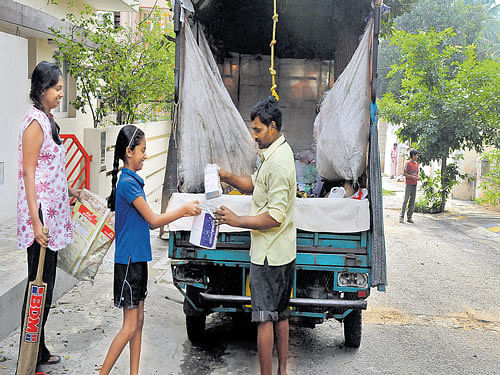
Around 4 years ago, the Bruhat Bengaluru Mahanagara Palike (BBMP) made waste segregation at source compulsory but at present, less than half of the city’s population follows the rule. While there are some who have taken it up as a challenge to keep their surrounding garbage-free, most are unclear about the guidelines for segregation, putting forth the question — is there enough awareness among citizens?
The need for waste segregation at source cannot be emphasised enough. Bengaluru generates nearly 3,500 tonnes of solid waste per day and civic authorities are running out of ways and places to dispose the garbage. Kabir, policy coordinator at ‘Hasiru Dala’, says that their initiative, ‘2 Bins, 1 Bag’, is being implemented in almost 3 lakh households in the city and Bengaluru is second only to Pune in its attempt at large-scale waste management, but this is not enough.
Explaining the intricacies of why people don’t segregate, he adds, “People have this wrong perception that sanitary workers don’t segregate and everything gets dumped in the same place. They think it’s pointless. But this is incorrect — the workers take out a lot of the dry waste and sell them to supplement their salary so people should segregate to help them.”
But it’s not just citizens who have to be open-minded. “According to the old contract, the waste is picked up at the door, moved to tippers and then to dumpyards. Contractors don’t want this to change so they are holding the government hostage. If there is segregation at source, these contractors lose money as they get paid according to the weight of the garbage. When the waste is mixed it is heavier, while segregated content moves through multiple channels and doesn’t merge in one place,” explains Kabir.
While the ‘2 bins, 1 bag’ initiative has been mandated by the Karnataka high court, the BBMP has also issued guidelines on segregation. And there are many households that have been doing it in their own way.
This is why rules of segregation depend on the area. Some, like Srini Vishnu Mohan, say that their apartments have made segregation compulsory and it is divided into 4 or 5 categories. “We have wet waste, dry waste, bio-waste and e-waste,” she says.
The BBMP also has categories for garden and hazardous waste. But the ‘Hasiru Dala’ initiative makes it easy for people — wet and bio-waste go in to the bins while dry waste is put in a recyclable bag. The problem, however, is drawing the line between dry and bio-waste; most people make an effort to segregate dry and wet waste but tend to dump sanitary garbage along with the others. Ideally, only bio-waste should be going to the dumpyards as, “Wet waste is sent to organic disposal centres and dry waste is recycled,” says Kabir.
How to discard waste
Dry waste
Includes: Plastic, paper, metal, glass, rubber, thermocol, styrofoam, fabric and leather.
Method: Wash, dry and store the items together in a recyclable bag as they aren’t collected everyday. Dispose of the contents into a larger dustbin (if you live in an apartment) or directly hand over to pourakarmikas.
Wet waste
Includes: Vegetarian and non-vegetarian kitchen waste.
Method: Avoid keeping in plastic covers. Layer the dustbin with paper, saw dust or dry leaves so that it doesn’t get dirty. Throw and wash everyday. If you have a garden, turn wet waste into home compost.
Bio-waste
Includes: Sanitary napkins and cloth, diapers, band-aids, waxing strips and anything with body fluids.
Method: Wrap in paper, mark with a red cross and hand over everyday. Do not mix with other waste.
E-waste
Includes: Non-hazardous electronic equipment.
Method: Store separately, keep away from moisture and hand over whenever necessary.
Hazardous waste
Includes: Items that contain chemicals — paint, cleaning agent, shampoo, pesticide, cosmetic, repellent, tubelights — and expired medicines and injections.
Method: Store separately, keep away from moisture and hand over whenever necessary.
Garden waste
Method: Either hand over to collectors and turn it into home compost.